What is Content Marketing
We have prepared this comprehensive guide to content marketing utilizing many different sources and our experiences. If there are any shortcomings that you notice in this guide, do not hesitate to share it with us.
What is Content Marketing?
Content marketing is a strategic marketing approach that enables the creation of consistent content of a certain value and relevance to a user audience identified previously and, as a result, mobilization of this audience.
As you may notice, the keyword in this definition is the word “value”. We can state that this word distinguishes content marketing from all other marketing and advertising methods. If users prefer to follow or benefit from an item rather than ignoring it, then this item is part of the content marketing strategy.
Content marketing should not neglect to motivate and take action from users after providing this “valuable” content to users. This action can be anything that brings value to your brand: Your users can share content within their network, subscribe to your newsletter, buy your products or give feedback. For this reason, widely preferred channels in content marketing activities include social networks, blogs, visual content and tools such as e-books or webinars offered to specific users.
Content marketing is perhaps one of the most useful among the versatile tools of digital marketing. This tool, which can be evaluated in different subjects or formats, can be easily adapted to any stage of the sales processes. However, this versatility can also lead some marketing experts to the mistake of producing only content. For this reason, a content marketing strategy needs to be established in order to reach the value and long-term goal of the content. Thus it will be possible to obtain ROI (return on investment).
Content marketing is not a process carried out with advertising content that does not seem like one. As Joe Pulizzi, the founder of the Content Marketing Institute said: “Content marketing is not about “what you sell”, it's about “what you stand for”. So content marketing is not about what you sell, but what your brand represents. When applied correctly, content marketing is the best way to create a bond with customers. When you apply the right content strategy, you gain trust and respect in the market. Your company gets positioned at the center of the discovery and purchase cycle, giving you a direct influence on what users see, read, and think.
The concept behind an effective content marketing strategy lies in telling stories that may interest people. Your content should not be seen by your users as a “marketing” or “sales” item. This will make it possible for you to sell more by “not trying to sell”! Your content should aim to promote your brand and increase its sales, as well as to help your customers, produce the values they find useful and meet their needs.
This will allow you to reach and influence more and more people. When you use it this way, your content marketing strategy will become the most powerful tool that sets you apart. If you answer “Yes” to the following questions, then we should point out that through content marketing you can reach these goals from the top to the bottom of the pyramid.
- Want to improve your reputation?
- Are you aiming to expand your social community?
- Looking for new resources?
- Would you like to increase the number of users who are subscribed to your list by email?
- Do you want to carry out your communication with your brand identity?
- Do you want to turn your customers into regular customers?
- Want to create an audience specific to a specific area?
In each content you create, it is also important that you reveal what you are targeting. This will not only help you determine the goals of your future content but will also help you keep track of existing content and measure their success.
Why Do Businesses Need a Content Marketing Strategy?
Understanding why businesses need it is probably more important than what content marketing is. Content marketing can seem like a huge burden compared to marketing methods with very fast returns such as list purchases, PPC (pay-per-click) or expo promotions where you can get your name and email address information in seconds. Content marketing is often used when businesses find that these methods are ineffective, too expensive, not applicable, or they have all of them. Let's take a look at the following examples that demonstrate the difference between content marketing strategy and other methods:
Let's say you're using PPC as your primary tool to build the customer pool your business needs. If you need more followers, let's say you bid $ 2 per click on that keyword. As a result of your campaign that lasts for months, 1,000 customers are created and you spend 20.000 USD in total. What about the next month? You will have to pay the same cost again in the next month and this will continue in the coming months. This is what you need to do if you want to continue to get customers with PPC. In other words, when you stop paying the piper, customers will stop coming. The same situation also applies to other channels and methods you obtain customers such as buying lists, or expo promotions. Now let's look at the opposite of this situation and talk about using a blog.
Let's assume that your visitor-to-customer conversion rate on your blog is the same as in your PPC campaign and is 2%. This; means that you will earn two out of 100 people who read your blog post in the first month as a customer. The difference between PPC and content marketing strategy is that you don't have to make the same effort in the same field in the coming months. Moreover, over time, the content in question continues to contribute to traffic directed to your site. Also, not only that post but every blog post you write will continue to function the same.
In other words, content marketing builds businesses on predictable, scalable and inexpensively directed traffic. It does not require regular repeated investments on this subject every month.
Content marketing contributes to other marketing channels. It provides additional content for social media marketing and contributes to SEO by creating natural internal links. Moreover, your site becomes more visible in search engines with more quality content. We can even say that the SEO work of many companies should be carried out depending on content marketing strategies.
Where to Start a Content Marketing Strategy
Below is the life cycle of a content generation process. We will discuss the steps of this life cycle later in our article.
There are two steps on which all successful content marketing strategy is based. These include:
Defining objectives
Task definition
.We can say that these two basic elements are the key elements of content marketing. Because they not only let you decide what kind of content to produce, they also help you understand what kind of content you should not produce by evaluating content projects from a business perspective.
In her book “Content Strategy”, Kristina Havoron, one of the industry's most successful names, presents the structure that you can see below to create a content strategy and mentions that this structure can be applied to both digital and offline content production. It also sets out exactly what you need to consider when creating a core content strategy for your business. In the gray-stained region, you refer to the content-related components - that is, the definition of objectives - while in the red-stained region you see the human, ie task definition part of the basic content marketing strategy. Now let's delve into some of these interconnected sections.
Content Components: What, Why and Where Questions
The substance is the component that forms your basic strategy in which you determine what content your business needs and what the main messages it wants to deliver. Substance should be based on the goals of your business and the interests of your target audience. Determines how to source and shape your content.
Audience profile you want to access
- What will the audience receive from your content
- What you want to talk about
- What is the main idea behind each section?
- What is the source of your content?
The second part of the infographic related to content is Structure. The structure is undoubtedly the component of your content's format, editing, and display. The questions you have to ask yourself about the structure of your content are as follows:
- What formats will your content have?
- What channels should you use to reach your target audience?
- How will users use your content?
- What are the most ideal channels to contact your audience?
- How should your content interact with other content?
- How to use metadata and other tags?
Once you have established the basic structure of your content according to the criteria listed above, it will be much more useful to direct the following questions to both yourself and the users so that they can appeal to users more.
- What are the two or three most important things people who come to your site or content want to learn / find or do?
- What are the top 2-3 things you want users who come to your site or content to learn / find or do within your site?
Your answers to these questions become the most important questions in the structure of your site and your content.
Human Components: How and Who Questions
The workflow is about revealing your content production process, identifying the tools you want to use, and identifying the people who run content marketing strategies that can successfully produce high-quality results.
- Who should be responsible for this in your team?
- How realistic are the time intervals to create content?
- Where will your resources come from?
- How will your content be published and will it affect the site format?
- At what stage will your content need to be reviewed and approved?
The last part of the infographic is the governance part, which is about who should make important decisions about your content or content strategy. Who is responsible for your business's content strategy?
- Who is responsible for your business content strategy?
- Who is your strategy officer?
- Who determines the format and style of the content?
- Who is responsible for the evaluation and review in the final stages?
- Who determines the workflow and process?
- Who is responsible for measuring the success of the work?
Research and Analysis
With the first step in the content marketing cycle, the research and analysis step, you can determine whether and how relevant your content is to your target audience and business needs. Whatever your company's goals, your marketing strategy and your content marketing strategies should all focus together on one or more goals. When determining the content strategy, it is important to know your company's marketing strategies on different sources and their basic approaches in these marketing strategies. Thus you can support content marketing strategies with the story that underlies each marketing theme and reinforce the expression of your brand.
1. Getting to Know Your Site
If you are not creating a new site from scratch or continuing from a small site, then you should start by reviewing your previous content. When you aim for a new content strategy, it is very important to make a detailed evaluation within the site. Thus you can get an idea about the current structure and the quality of your site.
If you want to make a quick and basic assessment of the parameters of the content on the site, such as traffic volumes and performance, you can create an inventory of the quantity of your content. This inventory may include features such as the location of content, formats, page types, traffic, bounce rate, social sharing, and links. You can also add parameters such as word count, readability values, author and date.
2. Get to know your audience
At this stage, you need to identify the audience to create your content. You need to work on what the needs of the audience are and how they can interact with the content. In order to understand your customer profile, you need to examine them as if they were members of your family. Here are some questions you may ask yourself to get to know and build your target audience:
- Where can you find your online audience?
- What attracts your audience's attention the most?
- What content topics and formats do they share?
- Do they have a sense of humor?
- Which newspapers / magazines / sites do they read?
- Who influences them?
- What is the right time to communicate with or reach them?
The best way to ensure that your marketing efforts are reaching the right people and interacting with them is to elaborate on your research. The methods that can be used for this can be found in the image below. In the image you can find descriptions of different methods, such as site analytics data, creating specific focus groups, and managing destination pages.
3. Identify the leading people in your industry that affect your audience.
People and organizations that have a positive impact on your target audience in your industry are key names in content marketing. It will be important to you at this point to know what they are talking about. People with this effect can be found in many places. Famous bloggers, journalists and industry experts are examples. If you intend to research them on social media, we can recommend Moz's Followerwonk tool. With this tool, you can identify people with authority who follow you or your competitors. You can compare your audience, see top tweets, and determine the right time to reach your audience.
4. Investigate your competitors in detail
Keeping track of your competitors can have an improving impact on your marketing efforts and content production in all areas. Thus you can get an idea of their strengths and weaknesses. Some things to consider at this point are:
- How are sites and their content shaped?
- What topics do they convey?
- What content formats do they use?
- How do they position their brand identities?
- How do they relate to their digital community?
- Are the contents successful?
There are several different ways you can use to investigate your opponents.
When analyzing a competing site, you may follow methods similar to the methods you apply to your site.
With tools such as Buzzsumo and Ahrefs, you can identify the most linked and shared content on your competitors' site, as well as the social media channels where their content performs best. You can also set up alarms with tools such as Google's alarm service or Talkwalker to keep you informed of your competitors simultaneously.
Planning: The Most Important Step of Your Content Marketing Strategy
So far we have set our goals and completed the necessary research, now the next step should be to develop the plan. When the subject comes to data, applications step with the information you collect, what Colleen Jones has said about this issue should not be forgotten:
"The data you have are your eyes, not your brain"
Creative planning is, transmitting the data and limitations you have in an operation after applying or transforming them into a product or multiple products with a specific message
The process of the collection of the accumulation of these different fields, brings together designers, researchers, team members and developers responsible for creative processes to develop new ideas.
1. Generating ideas
Creating stories that fit your target audience and purpose is very difficult. Your starting point should be to consider the issues that your target audience demands during your research. It may be difficult to determine how you will present the arguments that will be found in your content after you have determined the topic. The experts' suggestion for this is to identify the arguments you can talk to when chatting with friends. If your content manages to go offline instead of being online, you may verify that your choice of topics is really good. If you think you're in a deadlock, we recommend that you carefully read the following three approaches:
- Uncover an unknown and surprising subject related to an experience.
Look at the “Why? behind an event, norm, behavior, concept, myth. Even better: Correctly falsify general assumptions!
Tell something about a social norm, a famous product or concept that your audience doesn't know. This will be a content that will allow you to experience dialogues in offline life. An example of this is the infographic of the popular and simple The Renegade Pharmacy, which went viral. In this infographic, the pharmacy answers the question “What happens one hour after drinking coke?”
After this infographic was published, many sources started to prepare infographics about the effect of our favorite foods on our bodies.
- Produce identity-based content that tells readers something about themselves or about people they know.
We can give an example from Buzzfeed's British editor, Luke Lewis, who recounted a memory in his viral content activity. An article about a man who goes to Australia to see a little girl with Treacher Collins syndrome, who has the same genetic disease as her. He puts a decisive element in this article, which had a poor performance at the beginning, and says he is from Yorkshire. After this decisive item, this content is viral.
The reason for this was that readers in Yorkshire feel closer to the subject and are more likely to share this content with their network. After these shares, the network grew steadily, making the content viral.
- Use the nostalgia card
Nostalgia was once considered a psychological disorder. But today it is believed to be a neurological defense system. The longing for the past is universal, so it is not surprising that the use of nostalgia to reach the wider masses.
2. Determining content structure and formats
Conducting content marketing can make it feel like conducting an orchestra, organizing a wedding or preparing a show for the stage. It is a known fact that content marketing strategies in which a structured and formatted content is created to have a much higher success rate compared to marketing strategies unmanaged with such applications. As mentioned in the content Builtvisible, which we have benefited a lot in our content here, you can say that the structure of Curata's Content Marketing Pyramid is an important guide at this point. The Pyramid of Curata consists of five different levels with a total of three layers. Let's examine these layers separately.
- Level 1: Basic content
Basic content, by its very nature, involves research and understanding. On the other hand, assets are produced from these basic contents and experiences. We can give Books, e-books and guides as examples of the contents which we call assets at the top of the pyramid.
These assets serve as a source for the lower parts of the Pyramid as well as providing a transition to them. All assets in other parts of the pyramid aim to direct your visitors to these core assets and turn them into customers.
- Level 2,3 & 4: Derived assets
Assets in the middle of the pyramid are assets derived from the Basic Contents. With these tools, it becomes possible to present some of the basic content in smaller parts and focused more on specific features. These content are easier to access than others, and can come in a variety of formats:
- Long blog posts, presentations, infographics, and SlideShare (Level 2 & Level 3)
This type of content, depending on your man income target and growth strategy, is not aimed at generating revenue. This type of content is edited to reach the user directly, no matter what level they represent - ergo they also have the aim of redirecting towards the content you plan earning revenue from.
- Blog posts and distributed content (Level 4)
We can say that the content contained in Level 4 should be produced more widely than Level 2 and 3 content. They become part of the content production process on a weekly, if not daily basis, and serve as a different kind of tool for your content marketing strategy. We can say that this type of content is “bread and butter” for content marketing strategies. With distributed content, you aim to direct users to your core content using different media sources.
- Level 5: Micro - contents
At the bottom of the content marketing pyramid are the micro contents, which are based on promotional and communication. Level 5 content aims to increase awareness, consumption and action taking to the highest level for all your other content. An example of level 5 is social media sharing.
3. Writing plans
Each content marketing effort should have at least one basic asset (sellable assets) and a large number of micro-content, along with a few subsidiary assets derived from that asset. Planning and documenting all these assets is necessary to increase the benefits of content marketing. For marketers interested in publishing a new blog, it is important that the process is written and planned, based on keywords and user research, to ensure the success of the process.
When creating your to-do list, keep in mind that low-priority assets and micro-content must be flexibly planned. In this way, you can plan your content accordingly by following trends and events related to your basic asset and brand position.
Production Phase
Depending on the management structure of your company and your content, your content production process should be built according to a structure similar to the following:
- As you can see in this structure, the content publishing process is going through not only production and publishing, but also different evaluation processes. It is important for the content to reach its target by being published through the control of interested people who have different experiences and working in different departments.
Quality content instead of large quantities of content
When you start to produce your assets, always keep quality ahead of quantity. According to a recent survey by Acrolinx, 59% of users prefer not to shop from a website with bad grammar and spelling mistakes.
Source of your content
Although the experts in the content marketing and digital marketing industries have different opinions on this issue,
- according to Curata, 65% of your content should be original, 25% should be the arrangement of different sources and 10% should be directly related to other sources.
- The Huffington post gives a different approach giving the ratios of 30% source editing, 30% original and 30% experimental results.
Whatever method is useful to you, content collected from different sources is an important and general component of the content marketing strategy.
Curated - Collection content
Collection content simply means the use of excerpts, small sections and certain parts of content on other sites without any license infringement. The use of such content within your site in a manner specific to your content allows them to be used without license infringement. Buzzfeed is one of the largest implementers of the content in question on the internet with the lists it creates. With collection content, you can collect and use a large number of images, articles, anecdotes and quotes. The point you should pay attention is that you have to provide a link to the source from which you received the content in the content you just created and that you have used only a part of the content in question.
Licensed content
Licensed content can be quite expensive, in contrast to aggregate content, but these give you the right to use content written by a professional journalist. It requires less manpower than your own production ingredients, and is reliable along with being in a high standard.
User Generated Content
Placing the content created by your users at the center of a content marketing strategy is a highly effective way to promote your brand. User-generated content is now more active than ever. With the increase in smartphones and social networking users, the number of people sharing photos, comments, art and online music is also increasing. Moreover, Nielsen says that users' comments on a brand are the second best source of trust and that people trust each other more than they trust in advertising or product promotion. That is why the content that users create can be quite powerful. These contents bring a different level of support and customer trust.
A very cute example of such content is Starbucks's White Cup Contest. In this contest held in America and Canada, users were asked to share photos of their artistic designs using Starbucks cups. The winning design is printed on a limited number of Starbucks recycled cups to be sold. With nearly 4,000 people participating in the contest, we can say that Starbucks has generated a very large library of content created by users.
Spreading Content
The next step is getting your content to meet the right people.
In the research and analysis phase, you need to define your strategy, where you can find your users, what they like to read, and who they are inspired by. In addition, you should also know when they are most active online.
Before you start distributing your content, you'll also need to edit your content adequately. Thus that it should have the capacity to spread itself as much as possible. Then you need to log your content to the relevant publishers and communicate with people who have the power to influence people, interact directly with your users via social networks and email. Below is a list that can increase your chances of success in disseminating your content.
Create Powerful Titles
Although the “click-bait titles” created to pull you to click into the content overwhelm everyone's spirit, the success of powerful titles in enabling us to view content is undeniable. Create a few alternative headline ideas and test them on Twitter. Being a bit mysterious can help in creating effective titles. But be sure to avoid using titles to mislead your users.
Optimize Your Share Buttons and Social Markers
The share buttons should be visible within your site. It can be said that these keys appear at the top of the content leads to more sharing. It is possible to get more feedback with sharing buttons on social networks.
Targeted Meta Tagging
A clear, targeted title increases the likelihood that it will appear in the top positions of relevant keywords in search engines. Adding a targeted title tag, meta description and using keywords will also be useful. Here, the important thing is to avoid using too many keywords.
Create In-Site Links
In-site links have the effect of guiding visitors of your site towards specific content. If any content is of high importance, then linking to it from the home page is the most effective way to increase traffic to it. Alternatively, links to relevant destination pages or popular content can be a factor for users to stay on your site.
Sign Up for Google News
If your site has certain features, then adding Google News to it can lead to a significant increase in organic traffic performance.
Reaching Publishers
Reaching journalists and bloggers who are interested in a topic you've already published in is one of the most effective ways to ensure that your content is shared with the right people.
Share on Related Channels
Take a few tweets about it the day you post your content, and continue to do so in the coming weeks after the content is published. Also, don't forget to retweet your old content to attract attention. Upload images to social networks like Slideshare, Instagram and Pinterest. Be active on YouTube and regularly evaluate how you can reach your users with other popular social networks. (Eg Snapchat and WhatsApp). Emotionally interesting content attracts more attention on Facebook than Twitter. However, it may not be beneficial to share the same content over and over on Facebook. You can, however, consider sharing it over and over again on Twitter. Even though they are not free, you can also contribute to a viewing of your content on social networks like Outbrain and StumbleUpon.
Reach Your Users Directly by Email
If your email list is grouped by the user's profile, then you're more fortunate to send your content directly to relevant users.
Evaluate Your Content in the Offline World
You can also benefit from your content outside the boundaries of the digital world, especially if you want a particularly influential person to reach potential users (such as a journalist in a particular newspaper). It is a good way to stand out from the crowd of content in the digital world by printing out your visually valuable content, such as infographics or photo series.
Measuring Content Marketing Process & Monitoring and Evaluating Content
You are probably familiar with your content strategy and the statistics of your content. Your soft metrics measure interactions, returns, and brand awareness with your users, while your hard metrics consist of sales impacts and statistics from users who navigate to your site. Create a document that will keep track of all of this over time - such a reference will help to evaluate the performance of different content marketing efforts over time. It lets you learn from your experiences. It is enough to prepare even a single excel sheet to achieve this.
What to measure?
What you need to measure varies according to the objectives of your content. Assigning a limit value to different actions that do not allow you to earn direct earnings (for example, social interactions, email records, etc.) will help you measure the overall success of your work. Remember to set goals, be sure to determine the ideal scores for each measurement.
Retracting Content
Content marketing is a long-term process. Don't expect big changes with the first few contents you create. It is a time-consuming process to build a reliable source of high quality that embraces your brand's values. However, it is open to changes and it is useful to act according to the performance of your content. If content doesn't provide a return to you the way you expect it, don't hesitate to change your perspective and try something new. In such cases, try different “call to action” alternatives, test the success of different titles, and even consider changing your visuals. Is the content too dense and difficult to read? Are there enough images? You have to ask these questions regularly about your content. A small change can have a great effect. Just like Buzzfeed's Yorkshire example above. Feel free to make the right decisions at the right times.
Finding out who will manage your content marketing process
Content marketing requires manpower. The first step is therefore to find out who will manage the process. It is almost impossible to find someone that suits the structure of the entire team, and this will vary depending on the size of your company, your marketing team, and your budget. However, assuming that these three things are interrelated, it will be possible to provide a framework for how other content marketing-oriented companies work. This allows you to hire the right person and position these different areas in your company correctly. If you are a self-employed entrepreneur, or if you are working with a single person for marketing, the responsibilities should be:
- Prepare content - text and oral, long and short (a blog post for all users and the like)
- Optimizing content on SEO basics
- Social media management
According to Mike Volpe: " In fact, the best way to help your sales team is to build brand awareness and create content that generates a lot of leads over time. An increase of twice as many leads means twice as many quality leads -- as long as you have software that lets you filter those incoming leads efficiently. That's how you build a successful sales and marketing machine”.
At this stage; the work of one or two content marketers - content preparation, SEO and social media management - gives almost the same result as the work of a single person. As Volpe suggests, even if you hire two different people for the content marketing process, it is difficult to separate the responsibilities of two different employees. Both employees should contribute to these three obligations and the content marketing process should be shared between the two employees.
When your team grows, the division of labor can be:
- Blog Contents: Two employees
- Long / Premium content: One employee
- SEO: One employee
- Design: One employee
In a business of this size; there is usually a marketing manager with all these employees reporting. At this point, while the marketing manager manages the content marketing process, daily activities must be conducted by a team of five people. When it comes to a marketing team of around 20 people, your content marketing team will be run by employees of the same role – bloggers, long content creators, SEO experts, designers, and only doubling the number. At this point, you should appoint three employees from the team as the blogger and two for each other position. It may be wise to have one of the blog writers work as an expert in editing. Thus, as the activity increases, you have an employee who can maintain the quality of the content.
In an enterprise of this size; If you don't want hundreds of reports to be presented to your marketing manager, you should also have a leader for your content marketing team. He adjusts the budget, hires the right employees, contributes to content ideas, explores growth paths, and helps ensure coordination among other leaders within the marketing team to avoid the haphazard execution of the content marketing process.
Designers must meet the demands of employees in all teams. This; it makes them marketers dealing with the whole, rather than just focusing on the top of the pyramid.
You can also hire content creators who can design on their own. Those who can do ebook editing, create social media visuals, or do some simple, entry-level design work would be appropriate to this definition.
Keep in mind that your content marketing budget includes agency fees and contracted design work requested by third parties, when necessary.
Selecting the Team to Work for Content Marketing
Above, we've examined the different types of content marketing teams and the different professional groups you can work with. So, what do they do and how do you choose the right people for these roles? To get started, you can review some basic job descriptions below, along with the knowledge and skills an ideal candidate should have. Your specific needs may vary. For example, you can expect coding experience or expertise in a variety of subjects from team members who create long types of content. Or the job titles you need may change, and the “content creators” you are looking for maybe “content strategists” or “social media managers” who can be “experts” in this subject. You can make the appropriate changes in this direction. If you are hiring for the first time in any of these positions, the following draft can help you get started.
Blog Writer
We are looking for an expert writer who will join our blog editorial team. Candidates should be highly skilled and passionate about writing, as well as extensive knowledge of the industry. The blog author is expected to have the voice of the company over the entire blog content and to constantly improve in this function.
Responsibilities:
- Writing on a wide range of topics for the blog
- Providing feedback to other employees and editing the content of different writers
- Optimizing content for search engines and ensuring the dissemination of content
- Conducting analytical projects to develop blog strategies / tactics
- Increasing blog followers and blog access
Search Qualifications:
- Curiosity and sensitivity to the sector and the mission of your business
- Compliance with the style, quality, and ideas for the different content types of your business along with excellent writing and editing skills
- Analytical intelligence and interest in data usage in the optimization / scaling process of blog marketing strategies and tactics
- Independent working ability and organizational skills to manage projects with many different dynamics
- 2-3 years of experience in marketing and content preparation
Long Content Creator
The person you need to look for at this point is a talented and productive content creator who can regularly produce and write project and blog content, expand your company's digital footprint, awareness and customer pool. This position requires a high degree of creativity, a precise eye for detail and project management skills.
Responsibilities:
- Create 1-2 free content (such as ebooks, promotional articles, data graphics, guides, etc.) each month to ensure the continuity of clients, followers, awareness and other important variables
- By regularly providing blog content via users coming through search, social media, and email along with the support of other projects to attract site visitors
- Increase the number of subscribers by regularly creating appropriate and beneficial content to meet their needs.
- Collaborating with designers, product marketing and sales staff, non-business factors and industry experts to produce content fulfilling the needs of both stakeholders and target audience.
- To convince others that their ideas require time and effort. This position forms the core of the marketing team, and other employees base their work on what you do every day.
Qualifications to Seek:
- Bachelor's degree or equivalent level of work experience
- Especially experience in the production of content for the Internet and experience towards different social media platforms (blogs, SlideShare, Facebook, Twitter, etc.)
- The online or offline experience about expanding the audience
- A writer who creates excellent content which is quite creative should also be process-oriented. They should have multi-dimensional thinking skills and should be able to work with data for decision making.
Social Media Manager
- Who can increase the number of followers, ensure continuity and turn potential customers into active defenders and supporters of the company is ideal for this position. The social media expert should master best practices and trends of marketing, enjoy creating creative ideas, and learn how to build a digital audience.
Responsibilities:
- Strengthening and managing social media profiles of the company on Facebook, Twitter, Linkedin, Google+, Pinterest and other channels (Snapchat, Instagram, Vine, etc.).
- To create content suitable for different channels.
- To follow the conversations conducted on social media about the company, the sector or its competitors and to convert it into data.
- Regularly producing social media campaigns, promotions and following up their achievements from Twitter chats to Google+ Hangouts or LinkedIn conversations.
- Working in collaboration with other marketers and content creators to create content that will inform and entertain your target audience.
- Managing the traffic and customers from your social media presence stably and appropriately.
Qualifications to Seek:
- Bachelor's degree or equal work experience.
- Active and versatile social media using ability with mastery of each channel and best applications for them.
- Perfect communication skills and creative thinking abilities to use with both existing data and intuitive knowledge during the decision-making process.
SEO Expert
The SEO expert is responsible for identifying and actualizing opportunities that can enable the company and its content to improve on specific keywords.
Responsibilities:
- Performing both on-site and off-site SEO practices of the company
- Working in collaboration with blog writers to create high-quality content suitable for SEO
- Conducting the SEO process and enabling the target setting process based on traffic, click and conversion rate data
- Setting targets related to bounce rate and conversions
- Keeping track of the latest trends and changes related to SEO and major search engines
Qualifications to Seek:
- Bachelor's degree or equal work experience ranking
- Comprehensive knowledge of factors affecting organic rankings and optimizations, and algorithm updates
- Sufficient skills in web analysis and the ability to use keyword tools
- Excellent verbal and written communication skills
Designer
The designer is responsible for the creation and protection of the company's marketing methods and products, as well as content prepared to support other marketing objectives of products. This person; From theory to practice, it should be able to stimulate the brand and ensure its continuity on all contact points.
Responsibilities:
- Using the expertise and aesthetic knowledge to help bring out a new design and content ideas.
- Collaborate with long and short content writers to help revitalize their content.
- Preparing and editing templates for the team to make their posts more effective in social media, blog, email and other channels.
- In case of need; meet other design needs such as presentations, signboards and trade show designs.
Qualifications to Seek:
- Bachelor's degree or equal work experience
- Experience as an in-house designer in a marketing agency (You must request past work examples from applicants for this position).
- Design experience suitable for mobile systems / tablet systems and desktop systems.
- Specialization in Adobe Creative Suite and similar programs (HTML, CSS and JavaScript knowledge should be preferred.)
Obtaining Appropriate Content Marketing Tools & Technologies
The good thing about content marketing; Once you have the right person (or people) to do it, you'll get almost everything you need. At this point, you may also find it helpful to learn some of the basic tools and technologies you can use to publish content.
CMS - Content Management System
You should use a CMS to enable your content marketing team to create blogs and content without the need of an IT department or software developer.
Serpstat's new tool automates and helps you create unique content that brings more traffic to your site or blog!
Generate headlines and descriptions with ready-made text, paraphrase text and check grammar and spelling errors. Create your own articles or create them by extracting keywords from your existing text (or text you found by researching competitors).
Web Analysis Tools
To understand whether your content marketing performance is reaching your goals; you need an analysis tool for your website and blog. Some content marketing teams use Google Analytics; some may prefer other tools that can enable them to measure their content marketing efforts based on their earnings.
Project Management Software
With social media management and regular blog content creation, it is also important to have a project management tool since most of your content will be used for multiple campaigns and teamwork. To do this, you can use the free software called Trello, which helps you organize your content, set deadlines, attach files, and collaborate with multiple team members. Zerys is another tool you can use to organize your content projects from planning to publishing.
Design Software
Visual content plays a major role in the success of content marketing strategies. Adobe Creative Suite program provides content marketers with everything they need in creating content such as ebook, graphic design and social media images, etc. The design team will often be using InDesign, Photoshop, Illustrator, and Acrobat. As a free alternative, you can try Canva. This software makes it easy for designers of all levels to create visual content such as presentations, cover photos, advertisements, and more.
There are various tools available for creating infographics, including Adobe's own infographic tool. We have produced a substantial amount of interactive content by utilizing their infographic creator. We recommend exploring their free tool to understand the value proposition of utilizing a tool specifically designed for creating infographics.
Content Marketing and Artificial Intelligence
Artificial intelligence has entered our lives very quickly. Thanks to artificial intelligence applications that bring many changes with them, the processes of planning, executing and measuring our business have accelerated considerably. Naturally, this wind of change has also been reflected in content marketing.
So, do you know in which processes of content marketing you can benefit from artificial intelligence? Let's take a look together.
1. Finding Content Ideas with Artificial Intelligence Tools
It's often difficult to come up with a new content idea. Because many content ideas have already been realized. But there is never an end to ideas. As long as life goes on, original content ideas will continue to be born and implemented.
If you think you have a hard time coming up with ideas, we have great news for you: You can find content ideas with AI tools. Whether it's a blog post, social media content, video, e-book... Whatever type of content you choose, you can generate tons of content ideas using the right tools. And in minutes!
Let's make an app and find content ideas with ChatGPT.
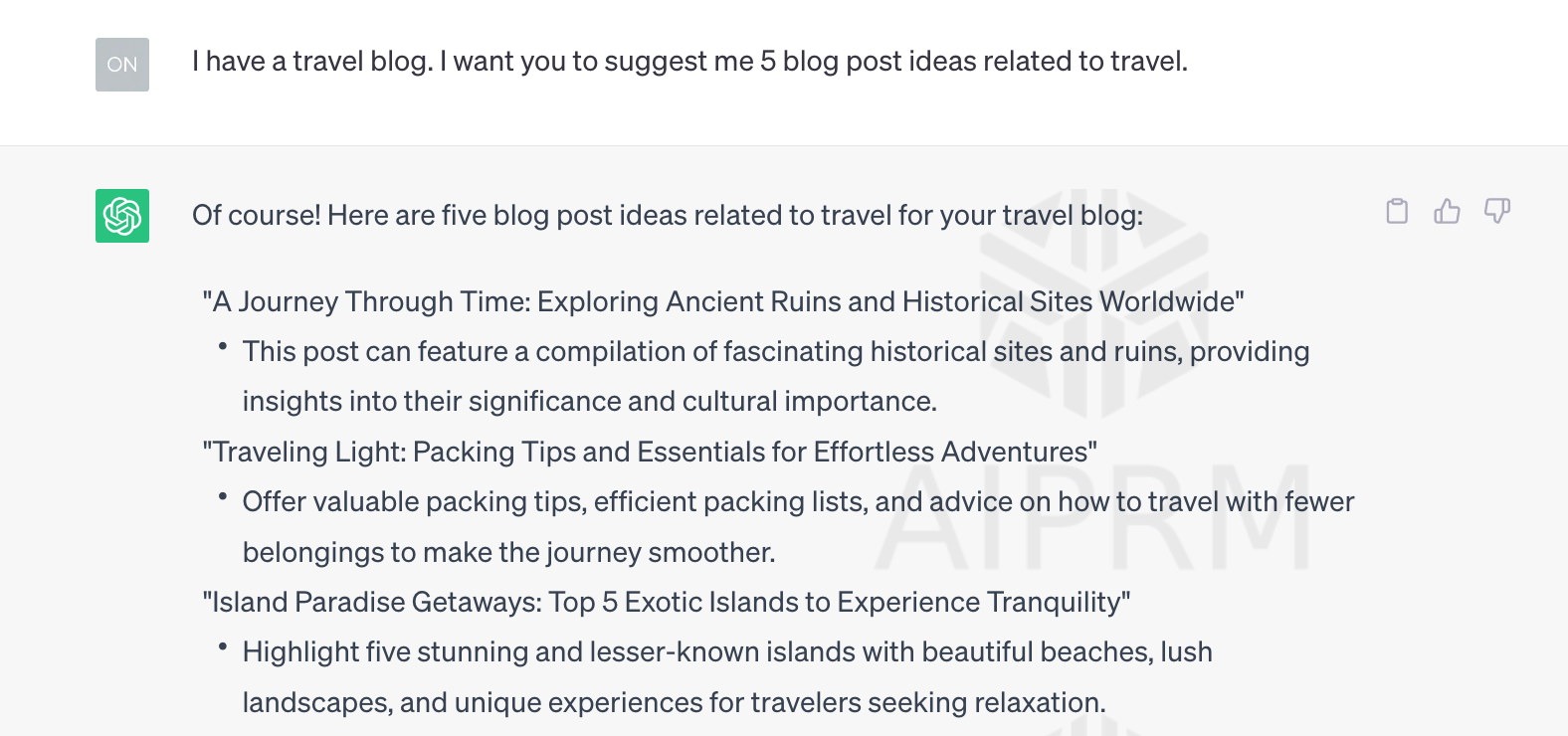
As you can see, we wrote a short prompt and it gave us the idea of instant content. You can also use Google Bard instead of ChatGPT. The choice is entirely yours. The reason why I made the prompt in English is that it gives better results in English. But you can also use it in Turkish. By entering the right prompts, you can generate hundreds of content ideas in minutes.
Moreover, you can increase your productivity even more by integrating applications like ChatGPT for work into Google Sheets. For detailed information about these integration processes and usage, you can take a look at our previous content on Social Media Content Optimization with ChatGPT for Work!
2. Creating a Content Calendar with Artificial Intelligence Tools
You've come up with content ideas, but as you can imagine, it's not enough just to come up with ideas. Putting them into practice in a planned way is just as important as coming up with content ideas!
There are many advantages of creating a calendar when creating a content marketing strategy. Because this way, you can create a consistent content publishing plan. This has a positive impact on your target audience.
So, do you know that you can create a content calendar with artificial intelligence tools? Let's show you with a small application!
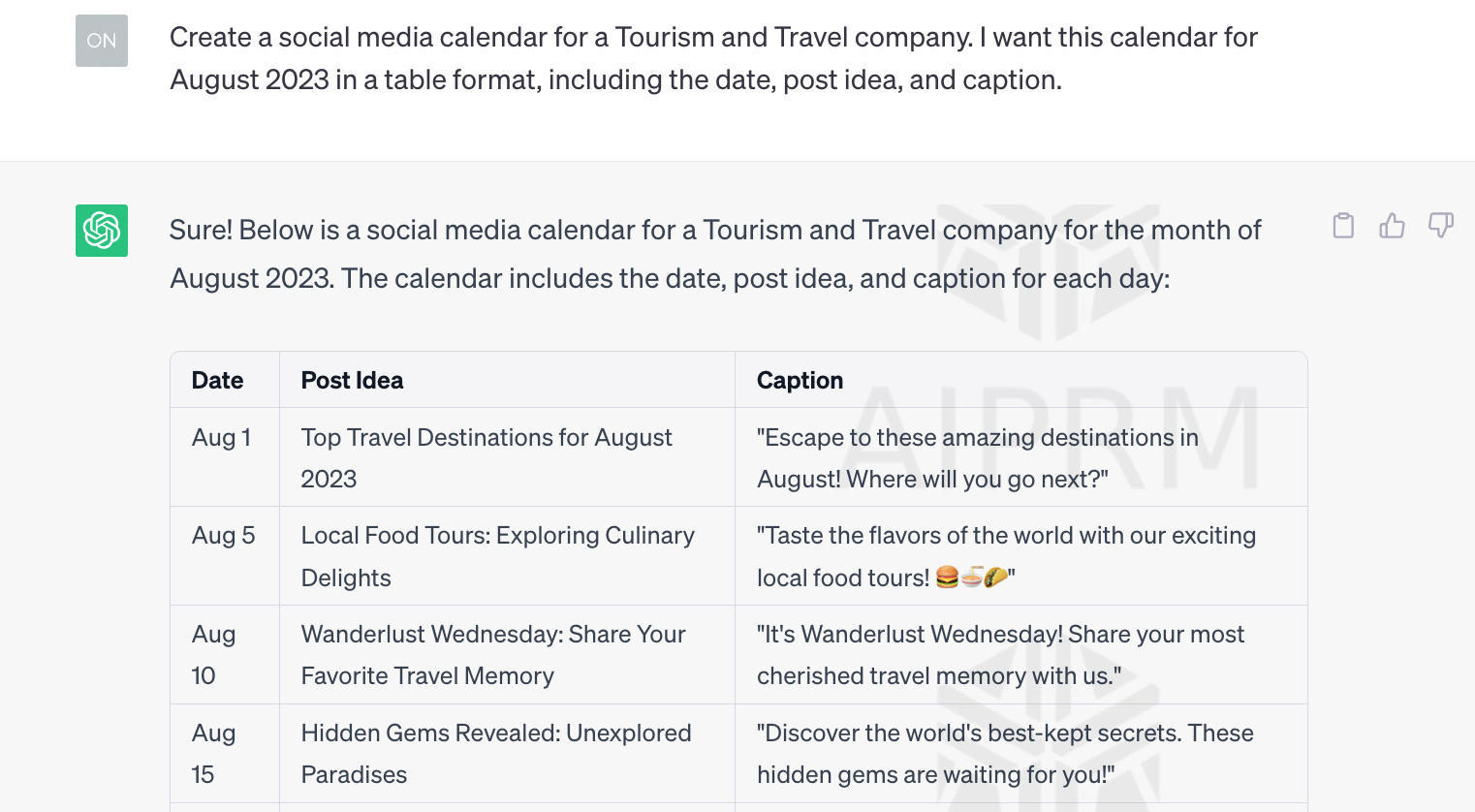
Simple, but effective. Very effective.
In seconds, we can create a content calendar with publication date, content idea and caption. Using this kind of content calendar, we can manage our content marketing efforts in a much more consistent and consistent way. You can use it for your website or your social media accounts. You just need to enter the right prompts.
3. Creating Outlines for Your Content
Before producing a piece of content, you should always do detailed research and create an outline. Just answering these questions will speed you up a lot in this process:
- Which topics will this content cover?
- Which topics will these topics cover?
- What will we cover in detail under which heading?
It may sound like a tiring process, but with AI, you can easily handle this challenging process. How? Let's show you by preparing an outline together!
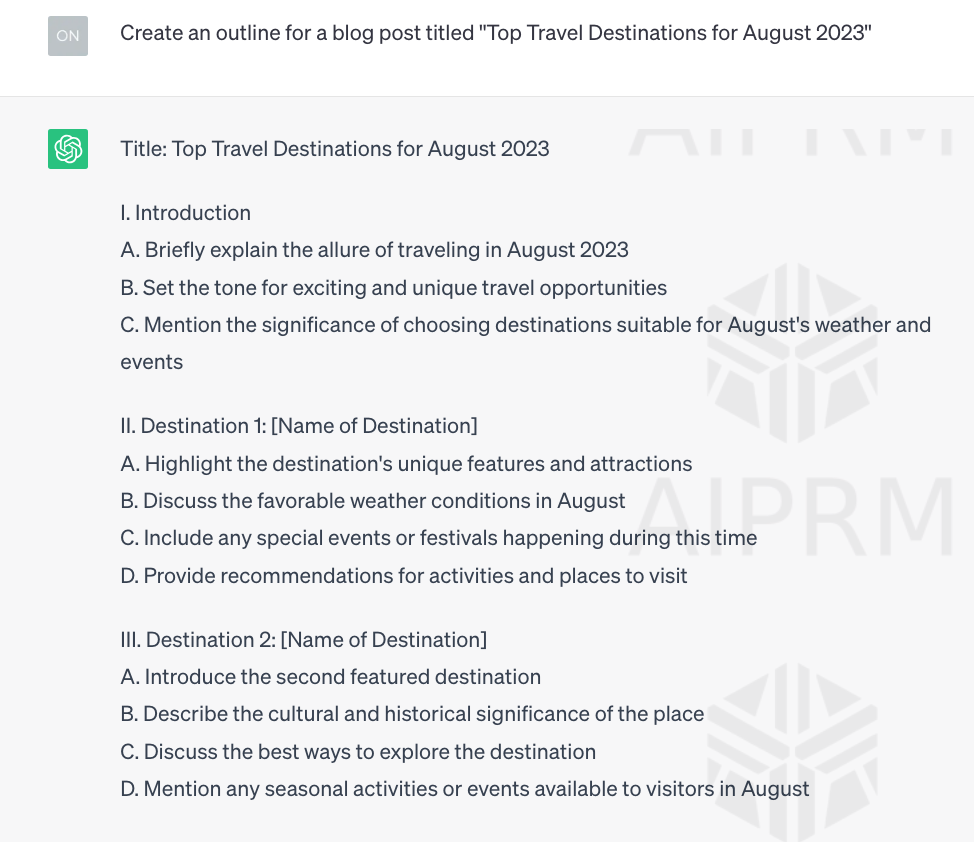
This outline will outline a piece of content we will create for the blog page of our travel-focused website. As you can see, creating an outline before producing content makes your job much easier. In this way, you don't experience many bottlenecks in the writing process. Because you specify in advance which topics you will address under which headings.
You can think of it as drawing your road map before you set off and following this map along the way.
IMPORTANT TIP: Creating an outline before producing content with AI tools will help you get much better results. Take care to create a detailed outline to get away from repetitive sentences and produce more effective content.
4. Creating Content with Artificial Intelligence
Now we come to perhaps the most important stage of content marketing: creating content. This stage is so important that unless you produce quality and effective content, all your efforts can be in vain. If you want to make a difference in content marketing, you have to create content that makes a difference.
With the development of artificial intelligence and the emergence of ChatGPT, there has been a revolution in content production processes. Various AI tools developed on the basis of ChatGPT have also started to be used in content production processes.
In fact, some websites have already introduced their AI-generated content to their users. At this point, you may also want to utilize artificial intelligence applications to produce content. So, how can you do this?
You have two options:
1. Use ChatGPT or Bard to generate content by entering the necessary prompts in detail.
2. Use paid tools such as Writesonic, Jasper, Wordtune, Rytr, etc.
In the first option, you feed the AI with prompts. One by one, you determine how many words the content should be and what kind of style it should be written in.
In the second option, the processes are easier. Because such tools already use the ChatGPT infrastructure. Since the AI is trained by sending prompts in advance, all you have to do is fill in some options and produce your content that way.
For example, the Writesonic tool includes the option to create content in bulk.
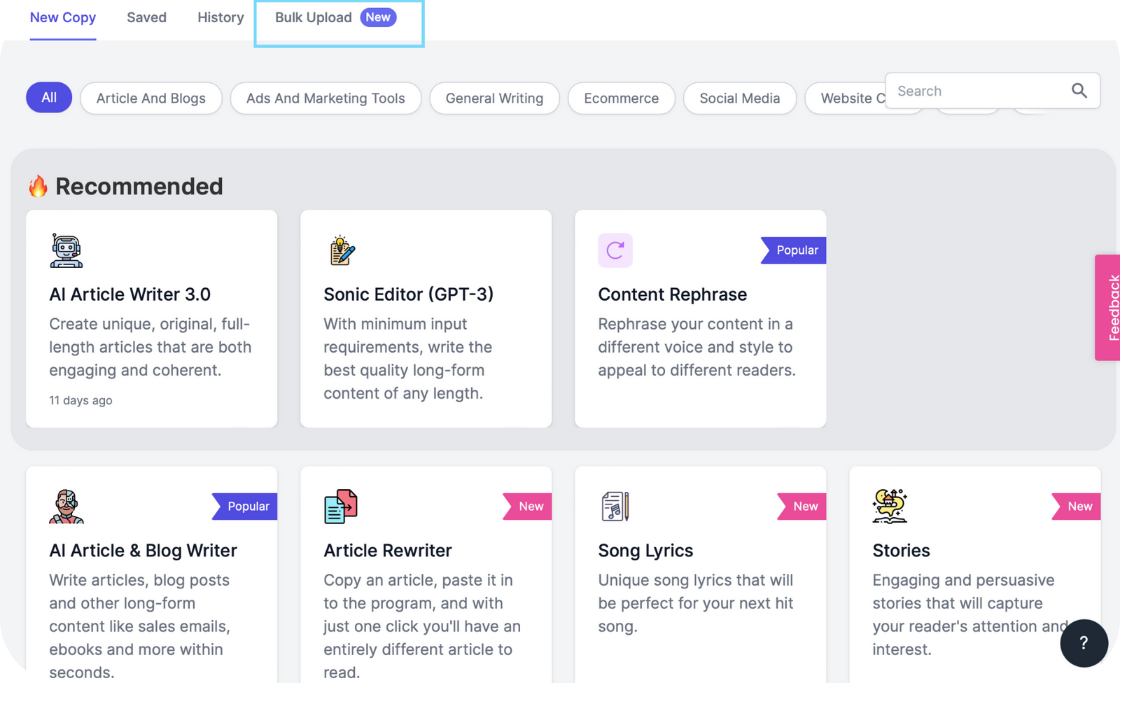
By choosing the language, features, etc., you have the chance to produce content more quickly. But of course these are paid.
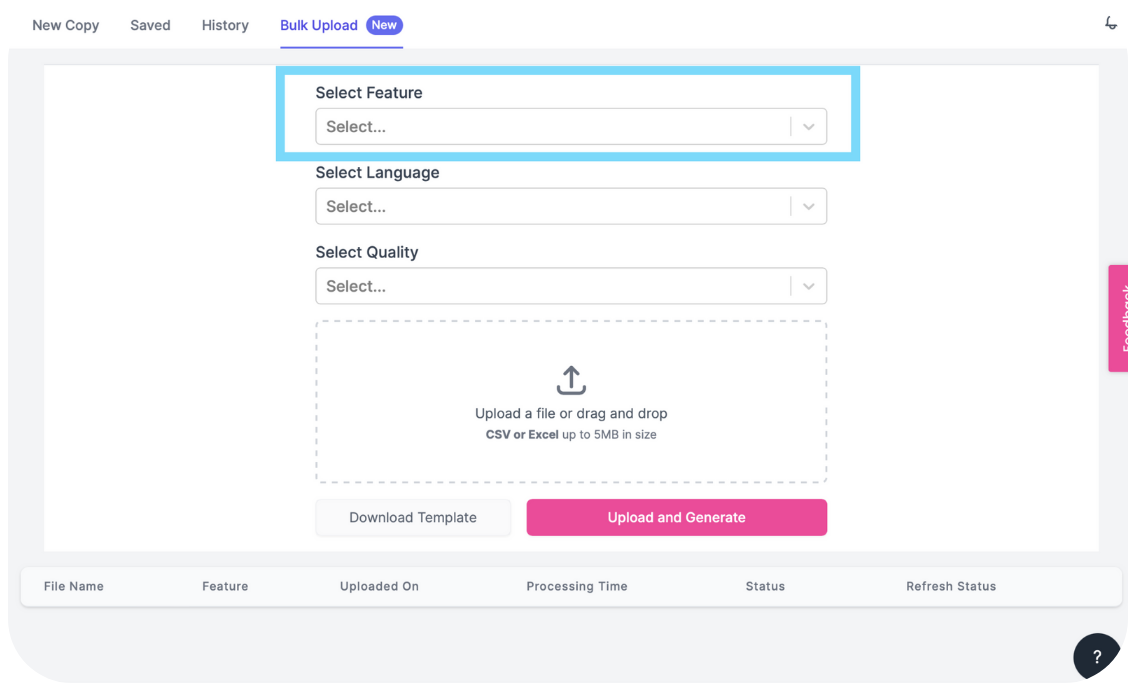
In Jasper, another similar tool, you have the chance to produce content close to what you want by filling in various fields. You can even choose the brand voice (the communication tone of the brand).
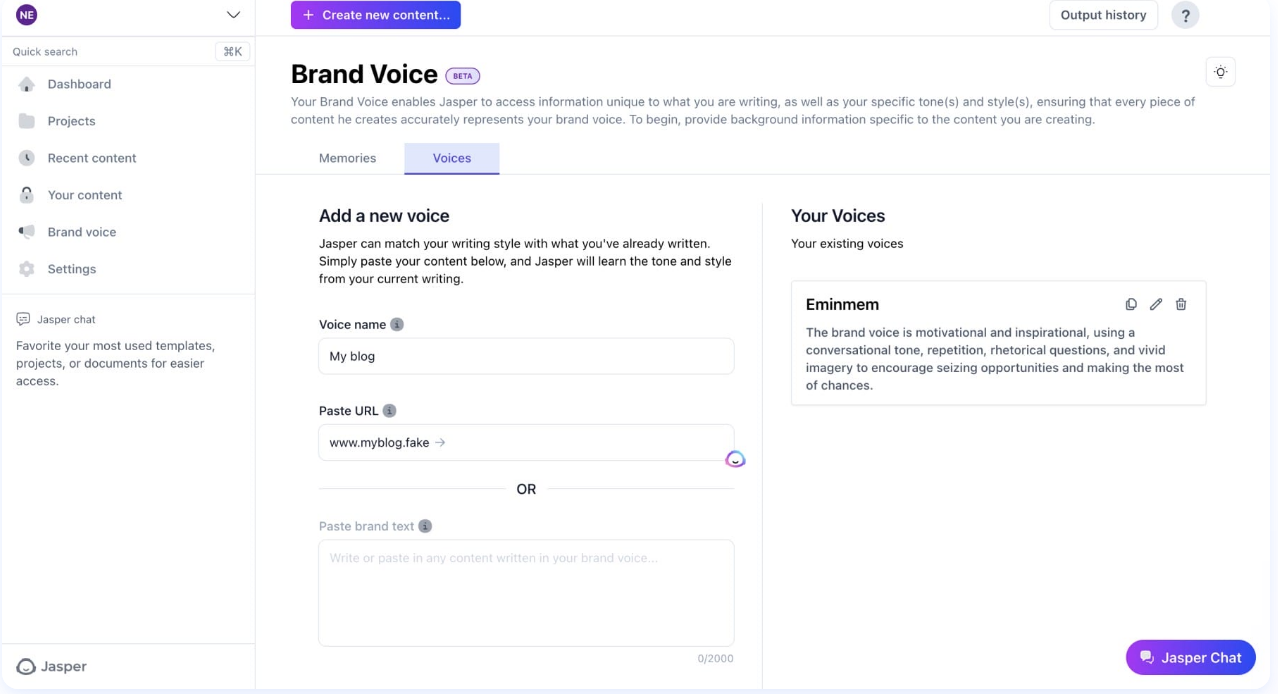
If you don't have the budget for such tools, you can use ChatGPT or Bard. So, how can you produce content with ChatGPT? Which prompts will benefit you?
Let's quickly create a blog content with ChatGPT. If you remember, we just created an outline for our blog content.
Now we tell ChatGPT to keep this outline in mind when creating the content.
We also tell it to write the content in a conversational language and make it look like it was written by a human being.
Here is the result:
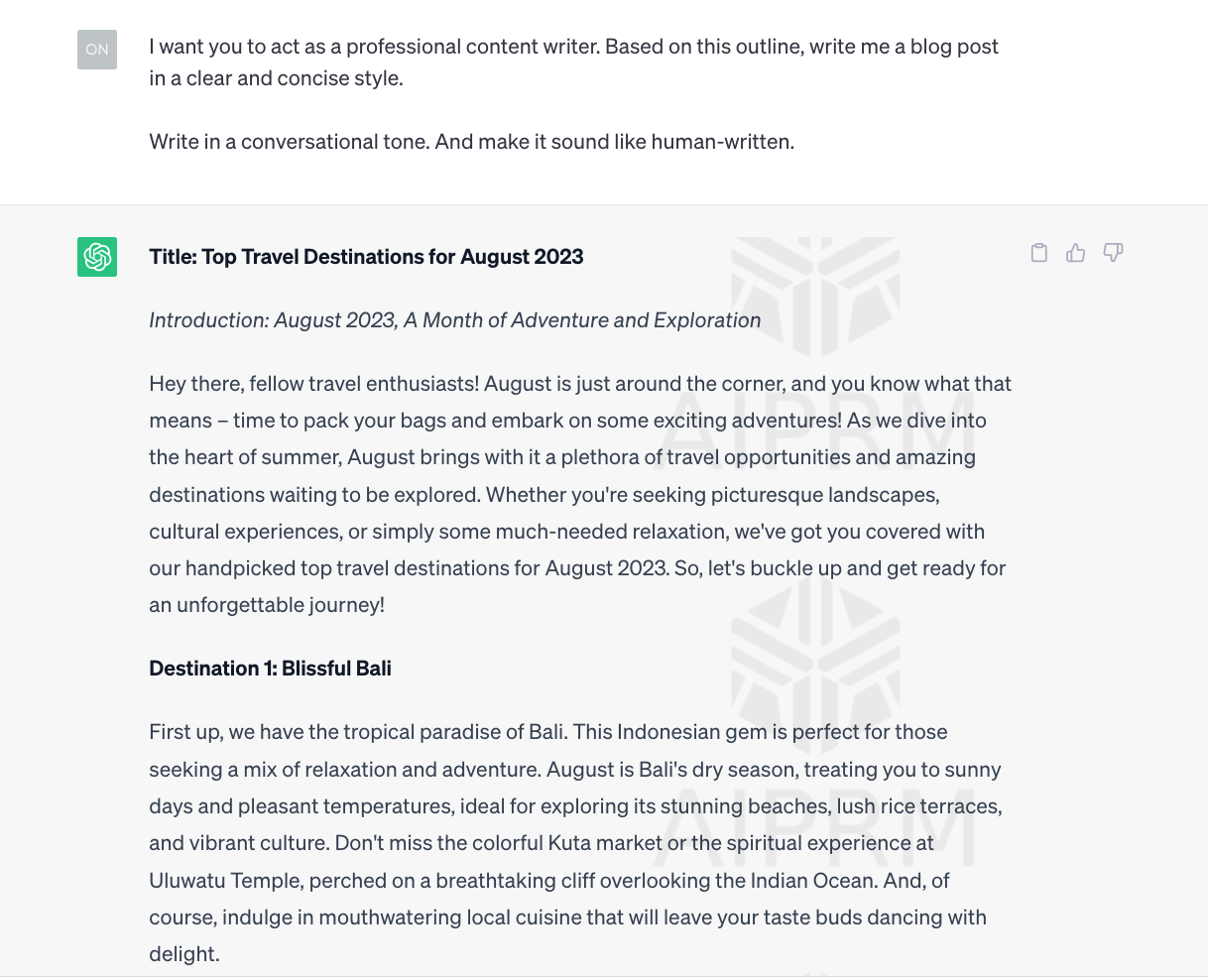

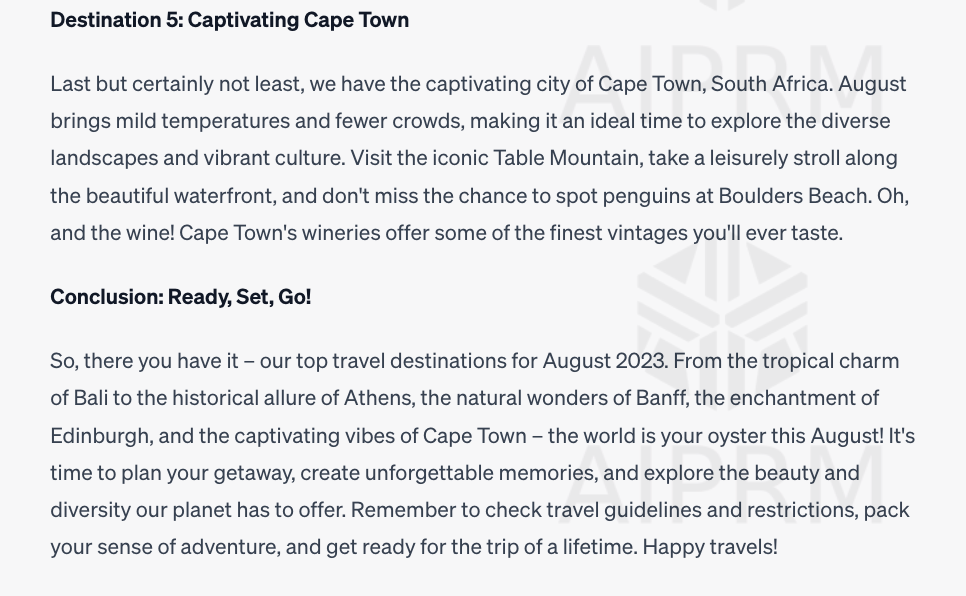
The more detailed the prompt, the better the result. For example, you can also specify who your target audience is and what kind of communication tone they like (professional or friendly?). You can say how many words the content should be. You can communicate that the content should include a hook at the beginning.
To produce the kind of content you want, you need to train the AI correctly and enter the right prompts. This way, you will be able to produce better quality content.
Also, don't just think of it as blog content. You can repurpose this content by turning it into social media content. Or you can write a script for video content. You can extend it even further and turn it into an e-book.
As you can see, content marketing is much faster and easier with AI tools!
5. Organizing Content
We came up with a content idea, created a calendar, outlined the content, produced the content and now it's time to edit it.
Editing content is as important as producing it. Because we edit spelling mistakes, spelling errors, communication inconsistencies and unnecessary word usage at this stage. This allows us to produce much better quality content. Remember, thanks to a good editing process, your content can have exactly the quality you want.
At this stage, you can again benefit from artificial intelligence tools. You can make use of ChatGPT and Bard, but you can also take a look at Grammarly. Grammarly has become much more useful, especially with the AI Writer feature. We strongly recommend you to check it out.
Let's take a look at how you can edit your content with Google Bard. First of all, we intentionally added spelling mistakes in the introductory paragraph of the content we just prepared with ChatGPT. Let's see if Bard can detect them and give us a clean version.
He types the required prompt and here is the result:
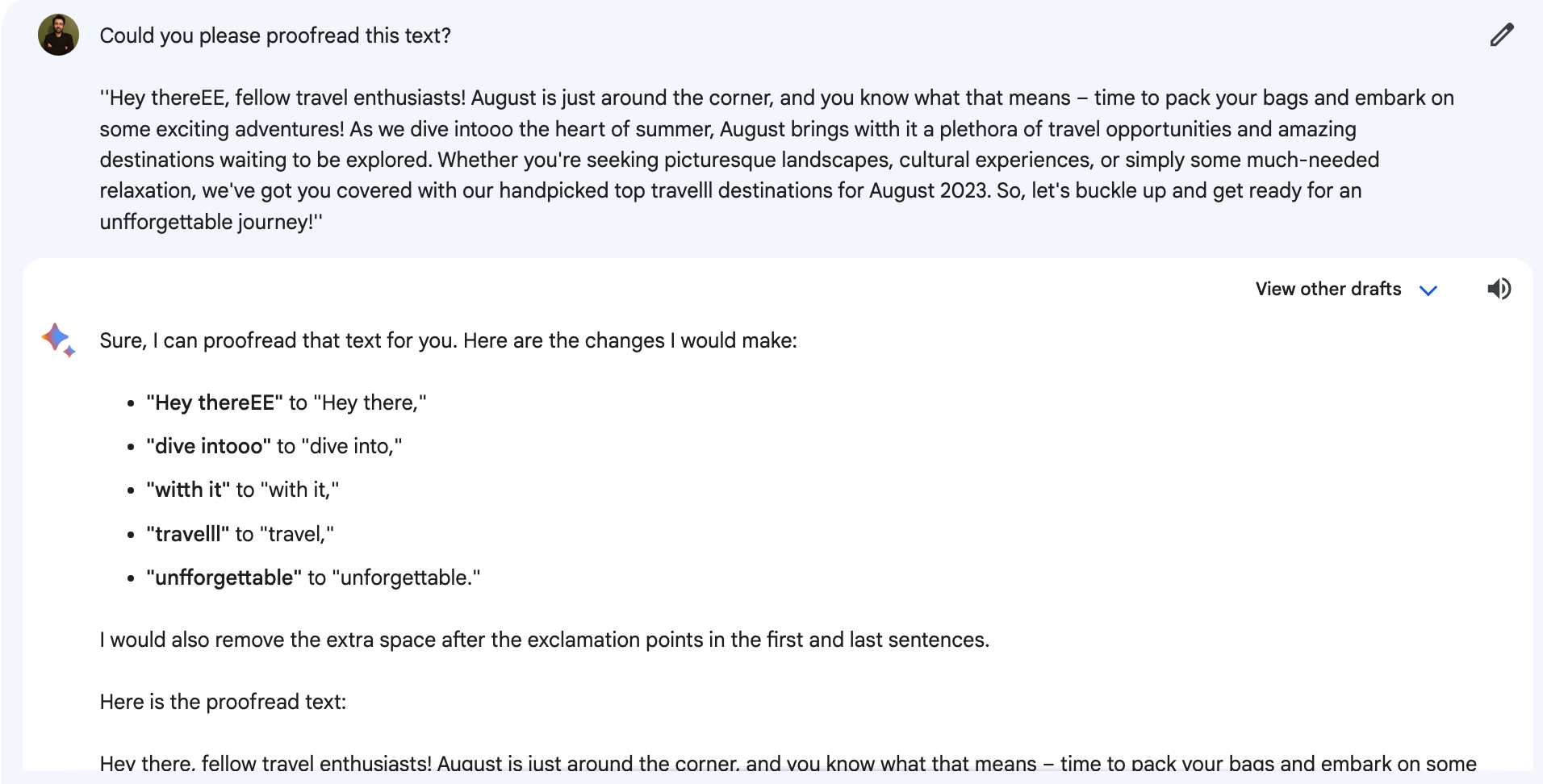
As you can see, not only did it give us an edited version of the text at the end, but it also told us which words we misspelled.
By using AI tools, you can quickly edit your content and get rid of annoying misspellings with ease.
Advantages of Artificial Intelligence in Content Marketing
We have provided important information on how to use AI effectively in content marketing, but what are the real advantages of AI at this point? Why should you conduct content marketing efforts with AI tools?
Here are the most prominent advantages:
- Writer's block is minimized.
- You gain speed. You will be able to manage your content marketing efforts much faster.
- You can produce more content in less time.
- You can use your time much more efficiently while producing and organizing your content.
- You can save money economically and have the chance to use your budget in different places.
Last Words
Yes, we have come to the end of our content. With this content, where you can find all the details you wonder about content marketing, we aimed to eliminate all the question marks in your mind. If you follow the advice we give in this content step by step, you will be able to benefit from the power of content marketing. In this way, you will create brand awareness, strengthen your connection with your target audience and increase your conversions.
If you want your brand to grow with content marketing and are looking for professional consultants, you are at the right place. We are ready to create the right strategy for you with our consultants who have experience in content marketing. We have served dozens of different brands in this field and have achieved great success stories. Contact us now to achieve success in content marketing!
Sources:
- http://contentmarketinginstitute.com/what-is-content-marketing/
- http://www.forbes.com/sites/joshsteimle/2014/09/19/what-is-content-marketing/#2c84b6e31d70
- http://contentmarketinginstitute.com/2014/05/essentials-getting-started-content-marketing/
- https://builtvisible.com/introduction-to-content-marketing/
- http://contentmarketinginstitute.com/2011/09/web-content-conversions/
- http://www.convinceandconvert.com/content-marketing/how-to-create-a-content-marketing-strategy/
- http://searchengineland.com/content-marketing-seo-bigger-picture-219796
- http://blog.hubspot.com/marketing/content-marketing-strategy-guide
- http://www.curata.com/blog/the-content-marketing-pyramid-how-to-generate-more-with-less/
- https://www.marketo.com/content-marketing/


















